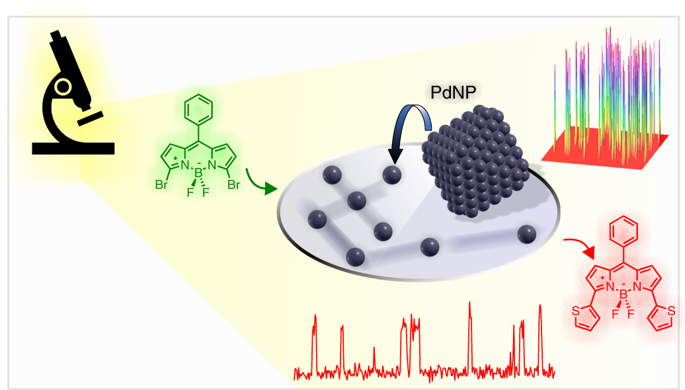Nature Catalysis ( IF 37.8 ) Pub Date : 2020-04-13 , DOI: 10.1038/s41929-020-0442-0 Paolo Costa , Deborah Sandrin , Juan C. Scaiano

|
The palladium-catalysed Suzuki–Miyaura reaction is one of the most important methods for C–C cross-coupling, yet the heterogeneous version of this reaction remains poorly understood. More specifically, the question of whether the reaction occurs on the surface of the catalyst (heterogeneous process) or is promoted by leaching of palladium species in solution (homogeneous phase) is still under debate. Here, we use real-time high spatial resolution microscopy to monitor a palladium-catalysed coupling reaction that produces a highly fluorescent BODIPY dye. We show catalyst migration during the reaction, which we attribute to a dissolution/redeposition mechanism where migrating palladium species become true active sites after attachment to the catalyst support. The observed process is heterogeneous, but the active catalysts (atoms or small clusters) have important mobility, as revealed by the observation of migrating catalytic sites. Our report shows the strength of single-molecule studies for unveiling fundamental mechanisms in heterogeneously catalysed reactions that are otherwise difficult to explore with classical ensemble experiments.

中文翻译:

异构催化的铃木-宫浦反应的实时荧光成像
钯催化的Suzuki–Miyaura反应是进行C–C交叉偶联的最重要方法之一,但对该反应的异质形式仍然知之甚少。更具体地说,该反应是在催化剂表面上发生(非均相过程)还是通过钯在溶液中的浸出(均相)而促进的问题仍在争论中。在这里,我们使用实时高空间分辨率显微镜来监测钯催化的偶联反应,该反应产生高荧光的BODIPY染料。我们显示了反应过程中催化剂的迁移,这归因于溶解/再沉积机理,其中迁移的钯物质在附着到催化剂载体上后成为真正的活性位点。观察到的过程是异构的,但是活性催化剂(原子或小团簇)具有重要的迁移率,正如观察到的催化位点迁移所揭示的那样。我们的报告显示了单分子研究在揭示多相催化反应中的基本机理方面的实力,而这些经典机理很难用经典的集成实验来探索。




























 京公网安备 11010802027423号
京公网安备 11010802027423号